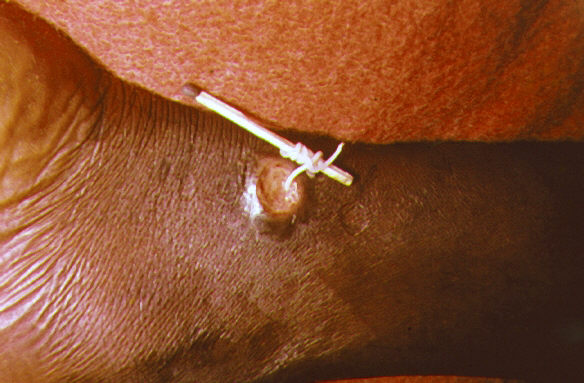In 1986, an estimated 3.5 million human Guinea worm disease cases annually in 21 countries in Africa and Asia.

Image/CDC
Yesterday, the Carter Center reported that the annual case tally has dropped to 28 in 2018, a slight drop from 2017 (30).
During 2018, 17 human cases of Guinea worm disease were reported in Chad, 10 in South Sudan, and one in Angola. None were reported in Ethiopia, where there had been 15 cases in 2017; nor were any human cases reported in Mali, where none have been reported since 2015. (Normally a lack of cases over such a long stretch would mean a country had interrupted transmission of the disease; however, Mali is still considered endemic, partly because of a few infections in domestic dogs and cats and because large areas are inaccessible to health workers due to insecurity.)
“Each of these cases is a human being with a family and a life,” said Adam Weiss, who was named director of the Guinea Worm Eradication Program in 2018 after nearly 15 years working with the program in four endemic countries. “These aren’t just numbers, these are people. This is why tens of thousands of volunteers, technical advisers, and staff are working in thousands of villages to find and contain the last cases of this miserable disease and show people how to wipe it out once and for all.”
Although the centuries-long story of Guinea worm disease is gradually coming to an end, the progress took a couple of turns in 2018: While human cases continue to dwindle, Guinea worm infections in animals continue to be reported; South Sudan detected new cases in May during enhanced surveillance activities after going 21 months with no cases reported; and a single, isolated case appeared in Angola, a country that had never reported a case before.
Jimmy Carter: ‘I’d like for the last guinea worm to die before I do’
Guinea worm disease (dracunculiasis) is usually contracted when people consume water contaminated with tiny crustaceans (copepods) that carry Guinea worm larvae. The larvae mature and mate inside the patient’s body. The male worm dies. After about a year, a meter-long female worm emerges slowly through a painful blister in the skin. Contact with water stimulates the emerging worm to release its larvae into the water and start the process all over again. Guinea worm disease incapacitates people for weeks or months, reducing individuals’ ability to care for themselves, work, grow food for their families, or attend school.
Without a vaccine or medicine, the ancient parasitic disease is being wiped out mainly through community-based interventions to educate people and change their behavior, such as teaching them to filter all drinking water and preventing contamination by keeping patients from entering water sources.
Of the many diseases that plague humankind, only one, smallpox, has ever been eradicated. Dr. Donald R. Hopkins, who was a key participant in the smallpox campaign and architect of the international Guinea worm eradication campaign and now is the Carter Center’s special adviser for Guinea worm eradication, calls disease eradication “the holy grail of public health.” Guinea worm, polio, and yaws are the only diseases currently targeted for eradication by World Health Assembly resolutions.
Trachoma: The SAFE strategy, the successes and a look forward to elimination
Lymphatic filariasis in Nigeria: The battle against the disfiguring parasitic disease


